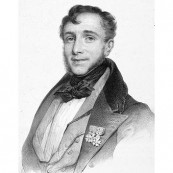Composers
Friedrich Wilhelm Michael Kalkbrenner (November 2–8, 1785 – June 10, 1849) was a pianist, composer, piano teacher and piano manufacturer. German by birth, Kalkbrenner studied at the Paris Conservatoire starting at a young age and eventually settled in Paris, where he lived until his death in 1849. For these reasons, many historians refer to Kalkbrenner as being a French composer.
At his peak, Kalkbrenner was considered to be the foremost pianist in Europe. When Frédéric Chopin came to Paris, Kalkbrenner suggested that Chopin could benefit by studying in one of Kalkbrenner's schools. It was not until the late 1830s that Kalkbrenner's reputation was surpassed by the likes of Chopin, Sigismond Thalberg and Franz Liszt.[1] The only serious rival he had was Johann Nepomuk Hummel.
Kalkbrenner was a prolific composer of a multitude of piano works (altogether more than 200), piano concertos, and operas.
Author of a famous method of piano playing (1831) which was in print until the late 19th century, he ran in Paris what is sometimes called a factory for aspiring virtuosos[2] and taught scores of pupils from as far away as Cuba. His best piano pupils were Marie Pleyel and Camille-Marie Stamaty. Through Stamaty, Kalkbrenner’s piano method was passed on to Louis Moreau Gottschalk and Camille Saint-Saëns.
He was one of the few composers who through deft business deals became enormously rich. Chopin dedicated his first piano concerto to him. Kalkbrenner published transcriptions of Beethoven's nine symphonies for solo piano decades before Liszt did the same.[3] He was the first one to introduce long and rapid octave passages in both hands – today so familiar from 19th century piano music - into his piano texture.
Today he is not so much remembered because of his music, but because of his alleged vanity.[4] Kalkbrenner was convinced that, after the death of Mozart, Beethoven and Haydn, he was the only classical composer left, and he never hesitated to let the world know this. Although of humble origins, he had a lifelong aspiration to be an aristocrat and delighted in rubbing shoulders with the nobility in London and Paris.[5] He is invariably described as a somewhat pompous, formal, overly polite, yet intelligent and business wise extremely shrewd man. He was the target of many anecdotes during his own lifetime and bitingly satirized by the German poet Heinrich Heine.[6] There hardly is any other composer who lives on in so many anecdotes and stories as Kalkbrenner.[citation needed]
Not much of his huge output has survived, although several pianists have taken some shorter works of his into their repertoire. A new recording[7] of two of his piano concertos (No. 1 and No. 4) was released in 2005; an older (and abridged) recording of the piano concerto No. 1 is still available. 2012 saw a new CD release of his second and third piano concertos.
Recently Added
Biography
Friedrich Wilhelm Michael Kalkbrenner (November 2–8, 1785 – June 10, 1849) was a pianist, composer, piano teacher and piano manufacturer. German by birth, Kalkbrenner studied at the Paris Conservatoire starting at a young age and eventually settled in Paris, where he lived until his death in 1849. For these reasons, many historians refer to Kalkbrenner as being a French composer.
At his peak, Kalkbrenner was considered to be the foremost pianist in Europe. When Frédéric Chopin came to Paris, Kalkbrenner suggested that Chopin could benefit by studying in one of Kalkbrenner's schools. It was not until the late 1830s that Kalkbrenner's reputation was surpassed by the likes of Chopin, Sigismond Thalberg and Franz Liszt.[1] The only serious rival he had was Johann Nepomuk Hummel.
Kalkbrenner was a prolific composer of a multitude of piano works (altogether more than 200), piano concertos, and operas.
Author of a famous method of piano playing (1831) which was in print until the late 19th century, he ran in Paris what is sometimes called a factory for aspiring virtuosos[2] and taught scores of pupils from as far away as Cuba. His best piano pupils were Marie Pleyel and Camille-Marie Stamaty. Through Stamaty, Kalkbrenner’s piano method was passed on to Louis Moreau Gottschalk and Camille Saint-Saëns.
He was one of the few composers who through deft business deals became enormously rich. Chopin dedicated his first piano concerto to him. Kalkbrenner published transcriptions of Beethoven's nine symphonies for solo piano decades before Liszt did the same.[3] He was the first one to introduce long and rapid octave passages in both hands – today so familiar from 19th century piano music - into his piano texture.
Today he is not so much remembered because of his music, but because of his alleged vanity.[4] Kalkbrenner was convinced that, after the death of Mozart, Beethoven and Haydn, he was the only classical composer left, and he never hesitated to let the world know this. Although of humble origins, he had a lifelong aspiration to be an aristocrat and delighted in rubbing shoulders with the nobility in London and Paris.[5] He is invariably described as a somewhat pompous, formal, overly polite, yet intelligent and business wise extremely shrewd man. He was the target of many anecdotes during his own lifetime and bitingly satirized by the German poet Heinrich Heine.[6] There hardly is any other composer who lives on in so many anecdotes and stories as Kalkbrenner.[citation needed]
Not much of his huge output has survived, although several pianists have taken some shorter works of his into their repertoire. A new recording[7] of two of his piano concertos (No. 1 and No. 4) was released in 2005; an older (and abridged) recording of the piano concerto No. 1 is still available. 2012 saw a new CD release of his second and third piano concertos.





